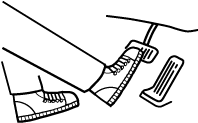 |
BRAKE FLUID AIR BLEEDING
id041100815300
Oil and chemical type
|
Brake fluid
Type: SAE J1703 or FMVSS116 DOT-3
|
|
Recommended fluid |
|---|
|
Type: SAE J1703 or FMVSS116 DOT-3
|
1. Switch the ignition ON (engine off).
2. Release the electric parking brake.
3. Switch the ignition off.
4. Remove the cap from the brake fluid reserve tank and add brake fluid.
5. Remove the bleeder cap of the brake caliper and connect the plastic hose to the bleeder screw.
6. Place the another plastic hose into a transparent container and immerse the hose end in the brake fluid during air bleeding.
7. Working with two people, one should pump the brake pedal several times and depress and hold the pedal down.
ac4ccw00001649
|
8. Working with two people, one should pump the brake pedal several times and depress and hold the pedal down.
ac4ccw00001650
|
9. Repeat the procedure from Steps 7 and 8 until no air bubbles are seen.
10. Perform air bleeding for all the brake calipers using the above procedure.
11. Clean the bleeder screw and the caliper.
12. After air bleeding, perform the following inspection: